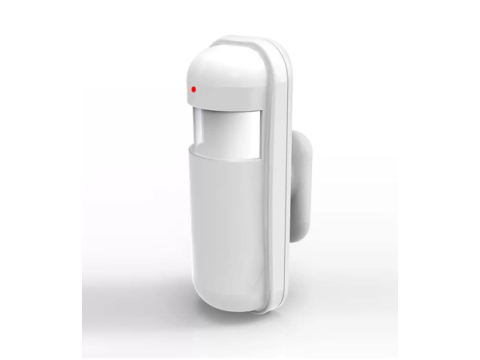Introduction
In security systems, the term “volumetric sensor” is somewhat misleading, since these devices do not measure volume per se. Instead, they detect movement within a predefined three-dimensional space (often with a 90° coverage angle, both horizontally and vertically). Essentially, a “volumetric sensor” is a motion detector that monitors a large area—whether via infrared (IR), microwave, or ultrasonic signals.
Below, we’ll explore the different detection methods, typical use cases, and best practices for installing and configuring volumetric (motion) sensors in security alarms and other automated systems.
Types of Volumetric Detectors
1. Infrared (IR) Motion Sensors
- Passive Detection: IR sensors detect changes in the thermal radiation within their coverage zone. When a warm object (like a person) moves through these zones, a pyroelectric module inside the sensor generates electrical impulses, which are then processed to issue an alarm signal.
- Coverage & Sensitivity: Typically effective up to 20–30 feet (6–10 meters) along the main axis of the sensor, with sensitivity dropping at the edges of the coverage area.
- No “See-Through”: IR sensors do not “see” through solid objects (walls, furniture, etc.). Windows, however, can admit strong sunlight or headlight beams that might cause false alarms if the sensor is poorly positioned.
- Use Cases: Commonly deployed in homes, apartments, and small offices for interior motion detection.
2. Microwave (MW) Motion Sensors
- Doppler Effect: These devices emit high-frequency radio waves (in the GHz range). If the waves bounce off a moving object, their frequency shifts slightly. The sensor detects this Doppler shift as motion.
- Penetration: Many materials (e.g., thin drywall, plywood) are partially transparent to microwaves. This can cause false triggers if there’s movement outside the intended space—such as in an adjacent room—unless the sensor is carefully installed or configured.
- Regulatory Note: Many MW sensors allow you to adjust detection range, thus fine-tuning the monitored zone.
3. Ultrasonic Sensors
- High-Frequency Sound: Operate in the 20–40 kHz range. The sensor emits ultrasonic waves and analyzes the reflected signals for Doppler shifts.
- Indoor Focus: Generally limited to one room or enclosed space, as ultrasonic waves don’t pass through walls easily.
- Adjustable Range: Like MW sensors, ultrasonic units typically include range controls to reduce false alarms caused by movement outside the intended detection area.
4. Hybrid (Dual-Technology) Sensors
- Combining IR and Microwave: A single sensor housing both IR and MW detection. The device triggers an alarm only if both detection methods sense movement, drastically reducing false positives caused by each technology’s inherent vulnerabilities.
Wired vs. Wireless Volumetric Detectors
- Wired:
- Often universal, working with a wide range of control panels.
- Requires running cables to each detector—labor-intensive but typically more reliable and tamper-resistant.
- Wireless:
- Uses a radio link to communicate with the alarm panel.
- Must match the brand or protocol of the receiving equipment, making cross-compatibility more challenging.
- Ideal where wiring is impractical or too costly.
Installation Tips
- Solid Mounting
- Fix sensors to rigid surfaces or walls to prevent false alarms triggered by vibrations.
- Avoid Direct Windows
- IR sensors can be overwhelmed by bright lights (sunbeams, car headlights).
- Microwave sensors might detect movement outside the intended room if placed opposite large windows.
- Consider Airflow
- IR detectors can mistake convection currents from heaters, AC units, or fans as motion. Keep them out of direct airflow pathways.
- Height & Positioning
- Mount in a corner near the ceiling for maximum coverage. Many IR sensors also monitor directly below themselves for “anti-tamper” detection.
- Microwave Frequency Litter
- If installing multiple MW sensors in one area, select devices with different frequency channels (listed in documentation) to avoid interference.
Wiring (for Wired Alarms)
- Typically, a relay output in the sensor remains closed in normal (armed) mode. Upon motion detection, it opens, signaling the control panel.
- Wireless Systems use addressable sensors that transmit digital data to the panel. You’ll need to assign each sensor a unique ID and define parameters (e.g., coverage range, sensitivity) in the control software.
Beyond Security: Other Applications
Video Surveillance
- Motion-activated cameras rely on embedded volumetric sensors to start recording only when movement is detected, saving storage space and reducing power consumption.
- Combined with GSM alarm systems, a triggered sensor can activate a camera and possibly send images to the homeowner’s phone or a monitoring station.
Lighting Control
- Motion sensors automatically switch lights on when a person enters the area, then turn them off after a set time of no movement.
- Great for energy savings in hallways, stairwells, and outdoor floodlights.
- While widely used in lighting, these sensors were originally developed for security and remain a primary choice for alarm systems.
Conclusion
Volumetric sensors are essentially motion detectors with a wide coverage angle, offered in infrared, microwave, ultrasonic, or dual-technology variants. Their flexibility and reliability make them a key component in both residential and commercial security setups. Proper placement—considering window exposure, HVAC systems, and potential external interference—ensures accurate detection and minimal false alarms.
- Infrared (IR) excels at internal detection, is cost-effective, and easy to deploy.
- Microwave (MW) can detect through some barriers but risks false triggers if installed incorrectly.
- Ultrasonic sees limited use but can be a solution for specialized indoor applications.
- Hybrid sensors combine IR and MW for higher accuracy in challenging environments.
For expert guidance and high-quality volumetric detectors, visit safsale.com. We provide tailored advice, ensuring you select the best sensor for your specific needs—whether that’s perimeter security, interior motion detection, or automated lighting control.

